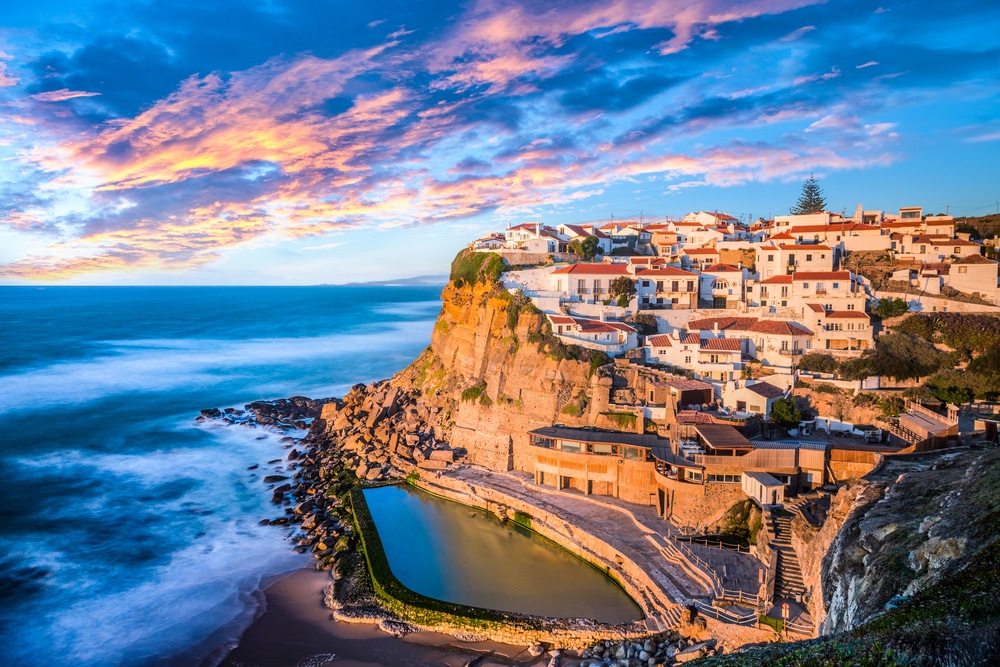There are few world-famous sights – Lisbon, the capital of Portugal itself, is a work of art in itself. Uphill and downhill, Lisbon always goes in two directions with the best view over the city to get lost in. Dreamy squares, picturesque corners, monasteries and magnificent palaces bear witness to colonial splendour; small charming corners and alleys are full of surprises. Green oases are followed by enchanting viewpoints, while the sun gives the city light and warmth 290 days a year. The City of Light is warm, open and relaxed – Lisbon welcomes its guests.
Lisbon – One of the most beautiful cities in Europe

Without a doubt, Lisbon is one of the most beautiful cities in Europe. Locals call it the “white city on the Atlantic”. However, Lisbon is located several kilometers from the sea on the north shore of the Tagus. From here, Portuguese sailors undertook their voyages of discovery and conquered a world empire for Portugal. The irresistible charm of bygone times is always present. Lisbon has had to cope with several momentous disasters in the course of its history. Such as the earthquake of 1344, followed by the devastating “great earthquake” of 1755 and a fire in the old town in 1988. These events caused immeasurable damage. Tidal waves, wildfires and earthquakes devastated much of the city. Magnificent monuments from the Middle Ages and Portugal’s heyday, the 16th century, were destroyed. In a city whose attitude to life is characterized by a melancholic world-weariness, today you experience a melting pot of different cultures with cosmopolitan flair.
Magical: the first view of Lisbon
Lisbon is located on the slopes of a rugged chain of hills with considerable differences in altitude of over 200 meters. Sensational views open up from the high-altitude districts. Some choose the secret route and reach the upper town on a contemplative ascent. Others decide to queue a little longer to take the historic Elveador de Santa Justain elevator to the heights of the upper town. From a 45-metre-high tower, 360 degrees of Lisbon open up. Since 1901, the passenger elevator has connected the lower town with the posh Chiado shopping district in the upper town.
Also rattling and groaning, the “Electricos” rumble up and down the hills. A must is a ride on the U 28, the oldest tram in the city. With the charming vehicle you can touch more Lisbon than anywhere else. The route leads from Praça do Comércio up to the Miradouro de Sants Luzia and back down to Martim Moniz.
Where art is on the street – Rossio, the center of the Baixa

The heart of Lisbon beats on the long Rossio square. Tie wearers, teenagers with mobile phones to their ears, chic shoppers in noble outfits, shoe shiners, loudly chattering street vendors, lottery ticket sellers as well as groups of Africans, gesticulating engrossed in conversation, cavort here.
Coming from Rossio through the pedestrian zone, on the way to Praça do Comercio , you can see the Arco da Rua Augusta from afar. The large triumphal arch as well as the equestrian statue of José I dominate the lively square. Admiringly, the gaze keeps grazing the sidewalk. Everywhere a special black and white paving stands out. Calçada Portugesa is the name of the art on the ground, which was created around 1500. Artistic marble mosaics with interesting and different motifs adorn the former representative forecourt to the Royal Palace and earn appreciation.
To the south, the Praça do Comércio is open. While a marble staircase lined with columns leads down to the river, there is a magical view over the wide riverside road to the Tagus.
To the districts of Lisbon
In the lower town on the Tagus, the view extends to the “Bridge of the 25th of April” and the Torre de Belém. The city’s landmark rises on the western bank of the river and captivates with a decorative work of domed turrets. Torre de Belém once served as a fortress and lighthouse.
Nearby is the Hieronymus Monastery. All the greatest sons of the country found their final resting place here. Since 1986, the monastery has been a UNESCO World Heritage Site. It is a gigantic structure that presents Portuguese power over a width of almost 300 meters. With its lavish decorations, the double cloister is one of the most beautiful in the world. Admission is free every 1st Sunday of the month.
Also in the Belém district is the Padrã dos Descorbrimentos seafarers’ monument. It was celebrated for the 500th anniversary of the founding of the city. The 100th anniversary of the death of Henry the Navigator was erected in 1960 and commemorates Portugal’s history as a maritime and colonial power.
Stroll through Alfama

Narrow streets lead to the family spheres of Alfama. Much of this exudes an enchanted Moorish-medieval atmosphere. Events and traditions of the residents come alive as their pictures on the houses tell a story.
The labyrinthine Alfama district is a small authentic neighbourhood and forms the core of Lisbon’s old town. Great restaurants and Fado bars line the narrow streets with winding houses and small squares that climb steeply uphill – up to the Castelo des São Jorge. Like a stone crown, the medieval castle towers over the city. The origins of the huge fortress lie in the time when the Moors ruled the Iberian Peninsula.
The seductive side of the Upper Town
Around the Chiado, the path leads to wonderful viewpoints. Visitors roam the noble district of Bairro Alto with noble restaurants, fado bars, smoky pubs and elegant clubs. For a long time, the Bairro Alto was the centre of Lisbon’s newspaper landscape. Even though the newspaper publishers have long since migrated, the flair of the journalistic scene has remained. In the evening, the dreamy streets of the Bairro are transformed into a turbulent spectacle mile.
Enjoy Lisbon with all kinds of delicacies
Just as port wine belongs to Porto, the Portuguese tartlets Pastel del nata belong to Lisbon. Tip: In the Confeitaria Pasteis de Belém you can find the best and most popular of these puff pastry pies with a delicious egg cream.
From custard tartlets to cherry liqueurs: No less popular are the delicious liqueurs, which have originated in the city’s monasteries since 1890. The tavern “A Ginjinha do Rossio” entices with sweet cherry magic and magically attracts locals as well as tourists.
An overview of the culinary highlights in Lisbon:
What would Lisbon be without a fantastic sunset?
Great location, great food: Ponto Final on the Tagus – the sun goes down, the sea rushes and you can enjoy a fairytale atmosphere with a delicious drink on the Tagus. Wildly romantic beauty: The water of the Tagus glistens in the setting sun and colourful ferries sail back and forth. The spirit of the past blows here! The charm of an old seafaring nation – it can still be felt.
This is the climate in Lisbon
| Month | Average maximum temperature (°C) | Average low temperature (°C) | Average rainfall (mm) | Average number of rainy days |
|---|---|---|---|---|
| January | 15 | 8 | 100 | 14 |
| February | 16 | 9 | 85 | 13 |
| March | 18 | 10 | 53 | 10 |
| April | 19 | 11 | 68 | 11 |
| May | 22 | 13 | 38 | 8 |
| June | 25 | 16 | 18 | 4 |
| July | 28 | 18 | 4 | 1 |
| August | 28 | 18 | 6 | 1 |
| September | 26 | 17 | 26 | 5 |
| October | 22 | 14 | 78 | 11 |
| November | 18 | 11 | 86 | 13 |
| December | 15 | 9 | 94 | 14 |
Lisbon enjoys a Mediterranean climate with mild, humid winters and warm, dry summers. The rainiest months are usually from November to February, while summer is particularly dry, especially in July and August. This climate chart can be useful in determining the best time to visit Lisbon, especially if you are planning outdoor activities.








